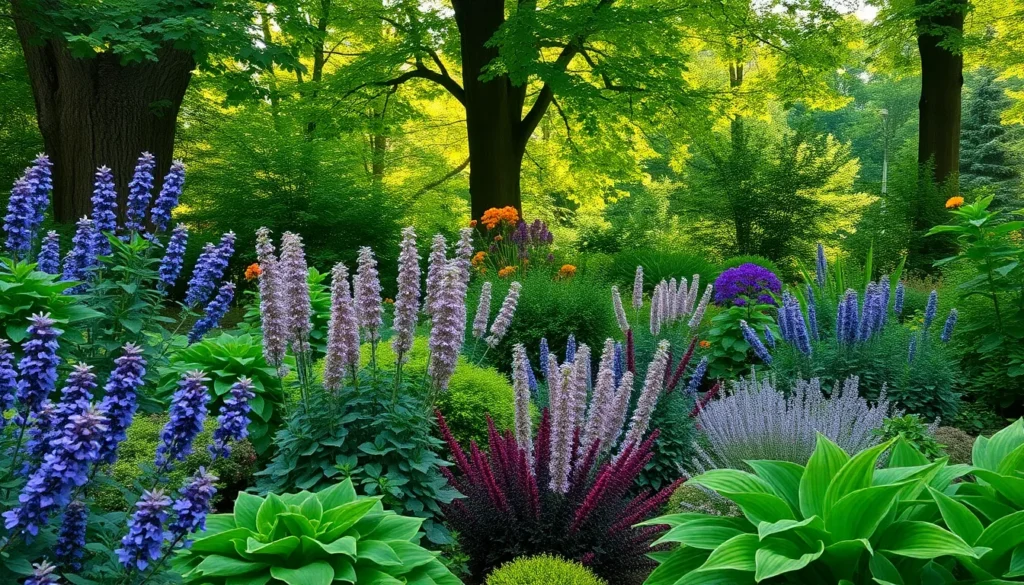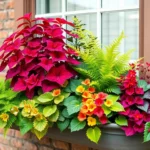Nothing’s more frustrating than watching deer munch through our carefully planned shade garden. We’ve all been there – investing time and money into beautiful plantings only to wake up to nibbled stems and bare soil where our prized specimens once stood.
The good news? We don’t have to surrender our shaded spaces to these persistent visitors. Plenty of stunning plants naturally repel deer while thriving in low-light conditions. These deer-resistant shade plants offer us the perfect solution for creating lush, undisturbed gardens that flourish beneath trees and alongside north-facing walls.
We’re about to explore the most effective shade-loving plants that deer consistently avoid. From fragrant herbs to textured perennials, these proven performers will transform your shadowy spots into thriving sanctuaries that remain beautiful year after year – without the constant battle against hungry wildlife.
Understanding Deer Behavior and Plant Preferences in Shaded Gardens
Before we jump into exact plant selections, let’s explore why deer make certain choices in our shaded garden spaces. Understanding these behavioral patterns helps us select plants that naturally discourage browsing while thriving in low light conditions.
Why Deer Avoid Certain Plants
Deer rely heavily on their sense of smell to identify safe food sources, making aromatic plants their least favorite garden options. Strong scents from herbs like lavender, rosemary, and mint signal potential danger to these cautious creatures. Texture plays an equally important role in deer feeding decisions, as they prefer tender, smooth leaves over rough or fuzzy surfaces.
Bitter compounds in many shade plants create an unpleasant taste experience that deer quickly learn to avoid. Plants containing toxic alkaloids naturally protect themselves from herbivore damage through these chemical defenses. Thorny or spiny vegetation presents physical barriers that deer instinctively avoid to protect their sensitive mouths and faces.
Deer feeding patterns change seasonally, with spring bringing increased appetite for new growth while winter forces them to browse on whatever remains available. Understanding these cycles helps us plan garden layouts that remain protected throughout the year.
Common Characteristics of Deer Resistant Shade Plants
Fragrant foliage serves as the primary defense mechanism in most deer resistant shade plants. Essential oils in herbs like oregano, thyme, and sage create powerful scent barriers that keep deer at bay. Plants with fuzzy or hairy leaves, such as lamb’s ear and dusty miller, feel unpleasant to deer tongues and discourage browsing.
Thick, leathery leaves found in plants like bergenia and hellebores resist deer damage through their tough texture. Bitter taste compounds in ferns, astilbe, and foxglove make these plants naturally unappealing to deer palates. Spiny or thorny characteristics in shade plants like barberry and holly create physical deterrents that deer actively avoid.
Dense growth habits in plants like pachysandra and vinca minor make it difficult for deer to access tender shoots. Plants with milky sap, including euphorbias and some perennials, contain compounds that deer find distasteful or potentially harmful. Strongly scented flowers in shade plants like marigolds and alliums extend protection beyond just the foliage.
Evergreen Deer Resistant Shade Plants for Year-Round Interest
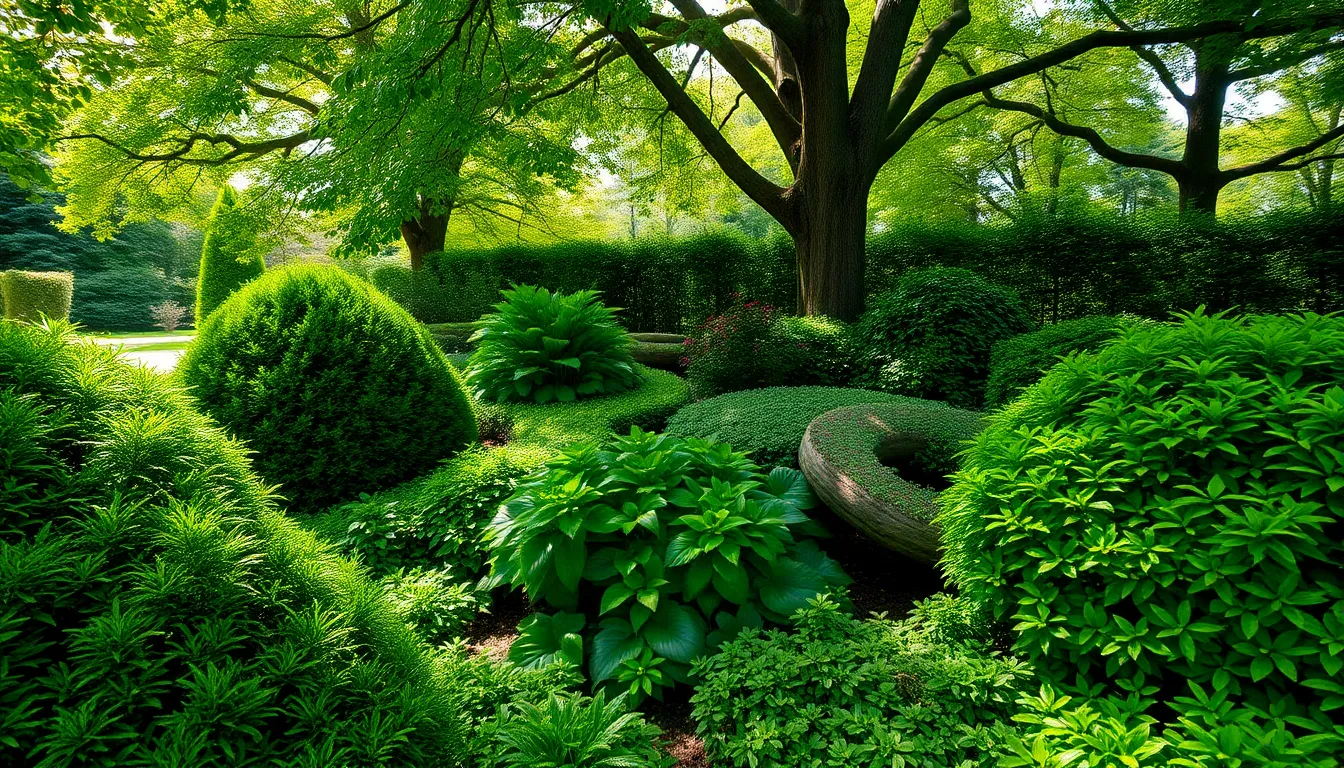
When creating permanent structure in your shade garden, evergreen plants offer the perfect solution by maintaining their foliage throughout all seasons. These hardy performers continue providing visual interest even during winter months when deciduous plants go dormant.
Boxwood Varieties for Formal Shade Gardens
Boxwoods represent the gold standard for formal shade gardening with their dense, deer resistant foliage and exceptional shaping capabilities. Green Beauty Boxwood grows 3-5 feet tall with glossy dark green leaves that maintain their rich color through winter in zones 5-9. This variety responds beautifully to pruning and can be shaped into hedges, spheres, or geometric forms for structured garden designs.
Wintergreen Boxwood excels in creating formal hedges and edging with its compact growth habit and reliable deer resistance. Green Velvet, Green Gem, and Green Mountain varieties each offer unique characteristics for different industry needs, from small border hedges to dramatic pyramidal forms. Dwarf English Boxwood provides an excellent option for smaller spaces while maintaining the classic boxwood appearance.
These versatile shrubs prefer partial shade conditions with well drained soil and benefit from regular watering during their establishment period. Their ability to tolerate pruning makes them ideal for maintaining formal garden structures year after year.
Japanese Pachysandra for Ground Cover
Japanese Pachysandra creates an exceptional evergreen carpet in shaded areas where other ground covers struggle to thrive. This low growing plant forms dense mats that effectively suppress weeds while providing consistent green coverage throughout the year. Deer consistently avoid this hardy ground cover, making it perfect for areas where other plants face browsing pressure.
Pachysandra terminalis spreads naturally to fill bare spots under trees and shrubs, creating a uniform appearance that requires minimal maintenance once established. Its glossy leaves catch and reflect available light in deep shade, brightening darker areas of your garden. The plant’s rhizomatous growth pattern allows it to establish quickly and provide long term ground coverage.
We recommend using Japanese Pachysandra under mature trees, along shaded walkways, and in areas where traditional lawn grass fails to grow properly.
Mahonia Species for Structural Appeal
Mahonia species bring bold architectural presence to shade gardens with their distinctive holly like leaves and natural deer deterrent properties. Oregon grape (Mahonia aquifolium) stands out with its spiny foliage that creates an effective barrier against both deer and foot traffic. These shrubs produce clusters of bright yellow flowers in late winter or early spring, followed by attractive blue black berries.
The plant’s structural leaves provide excellent contrast when paired with softer textured shade perennials and ferns. Mahonias tolerate various shade conditions while maintaining their robust appearance throughout the seasons. Their berries attract beneficial birds while the thorny leaves keep deer at a safe distance.
These evergreen shrubs work exceptionally well as specimen plants, foundation plantings, or natural barriers in shaded industry areas where you need both beauty and function.
Flowering Deer Resistant Shade Plants That Bloom Despite Low Light
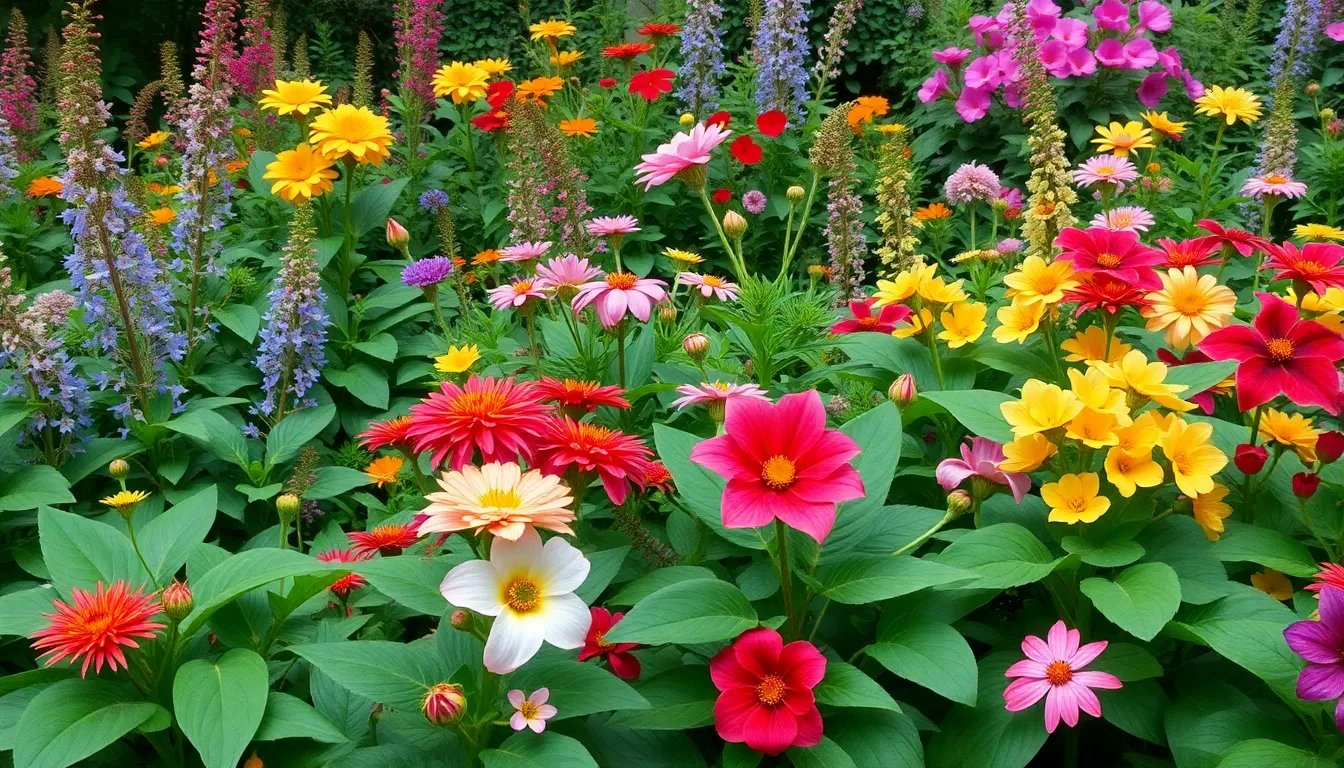
While evergreen plants provide structure to our shade gardens, flowering varieties add the vibrant colors we crave. These remarkable plants prove that deer resistance doesn’t mean sacrificing beautiful blooms in challenging low light conditions.
Astilbe for Colorful Plumes
Astilbe transforms shady corners with its spectacular feathery plumes that rise above ferny foliage in late spring through early summer. We love how these perennials produce vibrant flowers in pink, white, red, or purple shades that create stunning focal points in areas where most flowering plants struggle. The texture and taste of astilbe foliage naturally repel deer, making it an ideal choice for problematic browsing areas.
These plants thrive in moist, well-drained soil and tolerate partial to full shade conditions exceptionally well. Astilbe’s drought tolerance improves once established, though consistent moisture produces the most impressive flower displays. We recommend planting different varieties together to extend the blooming season and create layers of color throughout our shaded landscapes.
Hellebores for Early Spring Blooms
Hellebores earn their reputation as garden champions by blooming when virtually nothing else flowers in our shade gardens. These remarkable perennials, commonly called Lenten roses, produce elegant nodding flowers in muted colors like pink, white, green, and deep purple from late winter through early spring. Deer consistently avoid hellebores due to their bitter compounds and leathery leaf texture.
Full to partial shade conditions suit hellebores perfectly, while moist, rich soil helps them establish strong root systems. We appreciate how these plants persist for decades once planted, gradually forming impressive clumps that require minimal maintenance. Their evergreen foliage provides structure throughout winter months, making them valuable four season plants for our deer prone shade gardens.
Begonias for Continuous Summer Color
Begonias deliver the longest flowering season among our deer resistant shade options, blooming continuously from late spring until the first frost. We rely on these versatile plants to provide bright, showy flowers alongside attractive foliage that creates interest even when blooms fade. Their texture and chemical composition naturally deter deer browsing, allowing us to enjoy uninterrupted color displays.
Shaded to partially shaded locations provide ideal growing conditions for begonias, while consistent moisture keeps them blooming prolifically. These plants excel in containers, hanging baskets, or as colorful ground covers beneath taller shade perennials. We find begonias particularly valuable for filling gaps between slower growing permanent plantings while establishing our deer resistant shade gardens.
Foliage-Focused Deer Resistant Shade Plants With Stunning Leaves
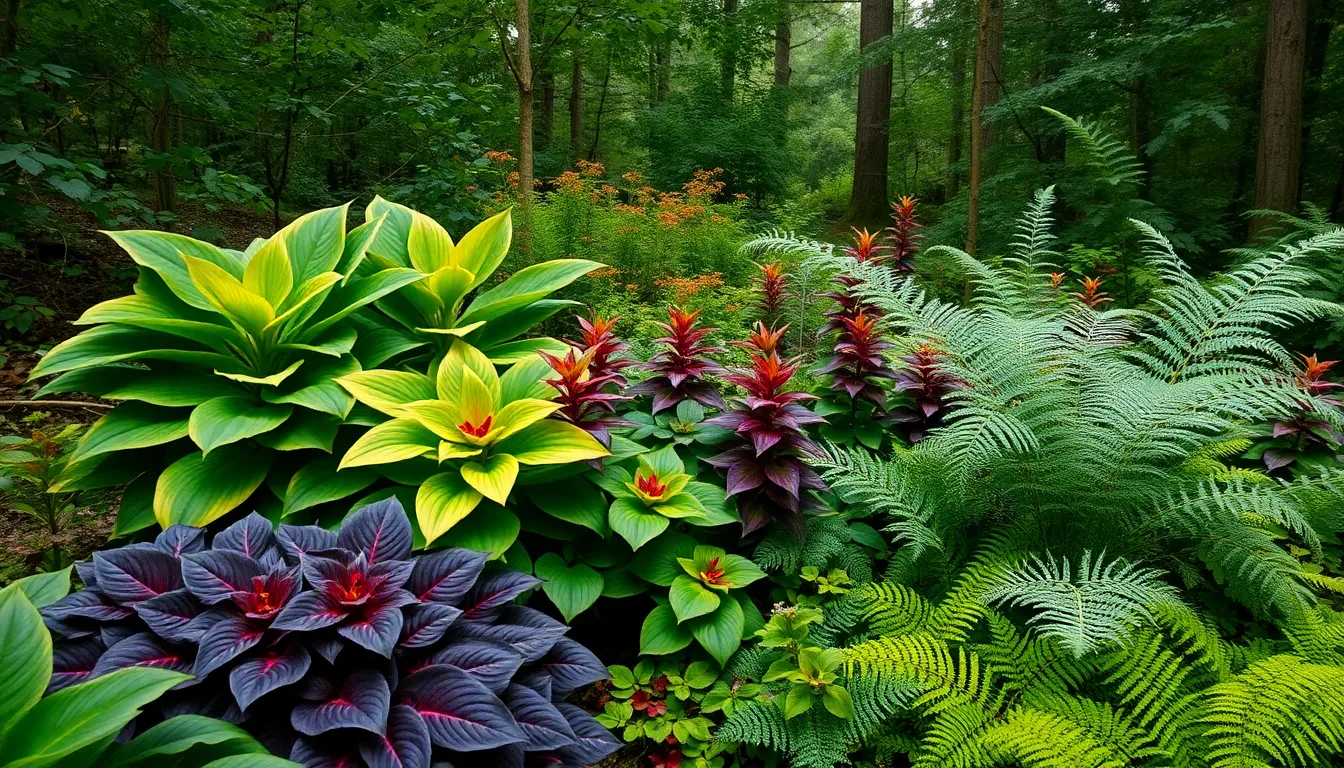
While flowering plants certainly grab attention, foliage plants create the backbone of any successful shade garden. We’ve discovered that many shade-loving plants with unique leaf textures and colors naturally repel deer through their distinctive characteristics.
Hostas With Strong Fragrances
Hostas stand out as classic shade garden staples with their lush, oversized leaves in countless varieties of colors and textures. We recommend selecting fragrant hosta varieties like Hosta plantaginea, which produces aromatic foliage that naturally deters deer browsing. These scented varieties combine the traditional beauty of hostas with built-in deer protection, making them perfect for shady areas where deer pressure is high. Fragrant hostas typically feature white or pale flowers alongside their distinctive leaf scents, creating multi-sensory garden appeal that deer find unappealing.
Heuchera for Colorful Foliage
Heuchera varieties, commonly called coral bells, deliver vibrant foliage colors ranging from deep purple to bright silver throughout the growing season. We love how these perennials thrive in partial to full shade while offering natural deer resistance through their mildly bitter taste and textured leaf surfaces. Their colorful leaves provide year-round visual interest, with some varieties displaying burgundy, chartreuse, or coral tones that brighten dark garden corners. Deer typically avoid heuchera due to the plants’ less palatable leaves, making them reliable choices for consistent garden color without browsing damage.
Ferns for Classic Woodland Appeal
Ferns represent quintessential shade gardening with their graceful fronds creating natural woodland atmospheres in any industry. We particularly recommend Japanese Painted Fern (Athyrium niponicum) for its stunning silvery-green fronds accented with purplish variegation that tolerates deep shade conditions. These ferns require well-drained, consistently moist soil but reward gardeners with exceptional deer resistance due to their unique texture and taste. Deer instinctively avoid most fern varieties, making them ideal foundation plants for creating lush, undisturbed woodland gardens that maintain their beauty season after season.
Aromatic Deer Resistant Shade Plants That Naturally Repel Wildlife
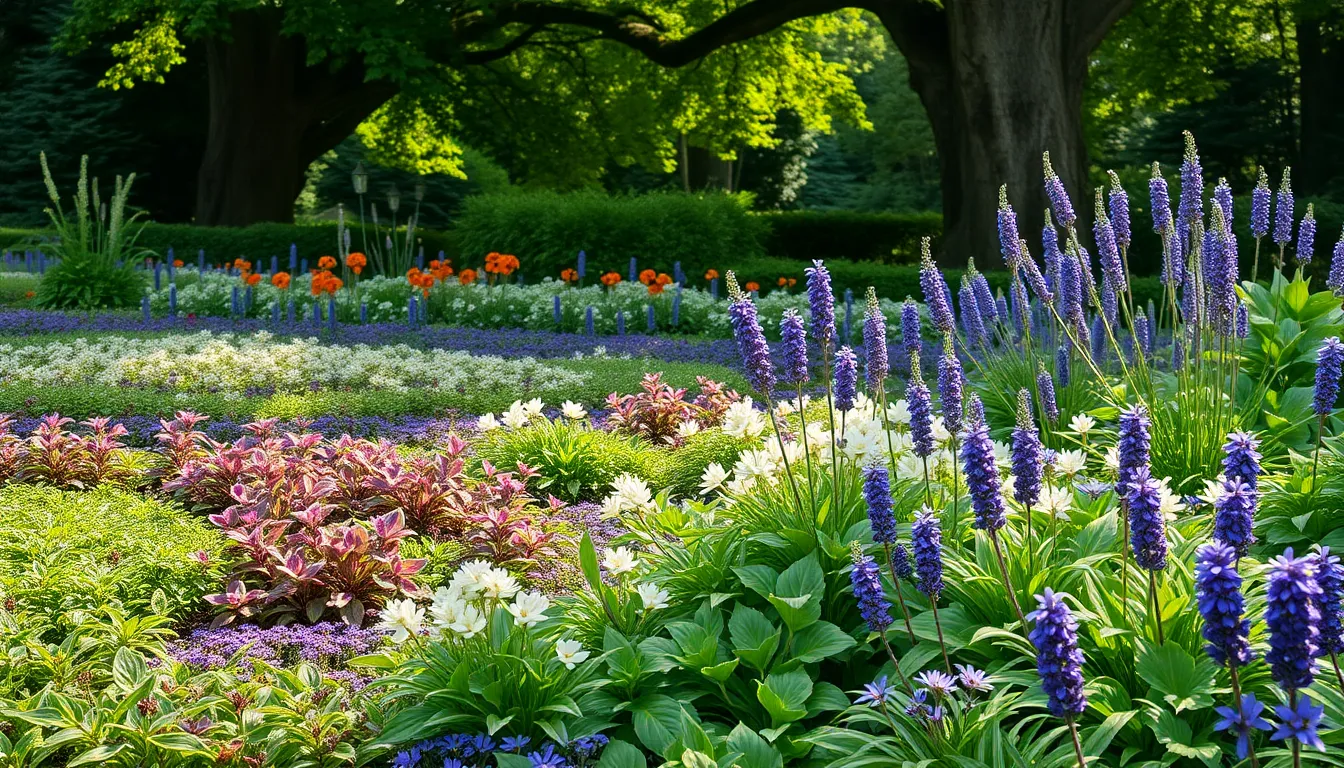
Strong scents from certain plants create natural barriers that deer instinctively avoid. These aromatic shade plants combine fragrance with deer resistance to protect your garden while adding sensory appeal.
Mint Family Plants for Shaded Areas
Sweet Woodruff stands out as our top choice for shaded gardens because it thrives in low light conditions while producing a pleasant scent that deters deer. Growing in USDA zones 3-8, this member of the mint family creates dense groundcover that spreads naturally through moist, well-drained soil.
Ajuga varieties offer colorful alternatives with their deer-resistant properties intact. ‘Black Scallop’ produces deep purple foliage that contrasts beautifully with spring flowers, while ‘Fancy Finch’ adds variegated leaves in shades of green, cream, and burgundy. Both varieties tolerate partial to full shade conditions and establish quickly in areas where deer pressure is high.
Aromatic foliage from these mint family plants releases oils that mask the appealing scents deer typically seek. We’ve found that planting these species in clusters amplifies their protective effects while creating attractive groundcover displays.
Lavender Varieties That Tolerate Shade
English lavender cultivars can survive in dappled shade conditions while maintaining their deer-repelling fragrance. Lavandula angustifolia varieties produce aromatic oils that remain potent even with reduced sunlight exposure, though we recommend choosing locations with at least 4-6 hours of morning sun for optimal performance.
Partial shade placement works best for lavender varieties rather than deep shade locations. Strategic positioning under high tree canopies or on the north side of structures allows these plants to receive filtered light while retaining their characteristic scent profile.
Aromatic oils in lavender remain concentrated enough to deter deer even when plants receive less than full sun. But, flowering may be reduced in shadier conditions, so we focus on foliage fragrance rather than bloom production when using lavender in partial shade areas.
Sage Species for Fragrant Foliage
Salvia species contain powerful aromatic compounds that make them excellent deer deterrents for partially shaded areas. Many ornamental salvias adapt well to light shade conditions while producing fragrant foliage that releases scent when brushed or disturbed.
Native sage varieties often show better shade tolerance than their ornamental counterparts. These species have evolved to thrive in woodland edge conditions where dappled sunlight creates ideal growing environments for their aromatic leaves.
Strong scents from sage plants intensify during warm weather, creating invisible barriers that deer recognize and avoid. We recommend planting sage varieties along garden borders or pathways where foot traffic will release their protective fragrances throughout the growing season.
Ground Cover Deer Resistant Shade Plants for Problem Areas
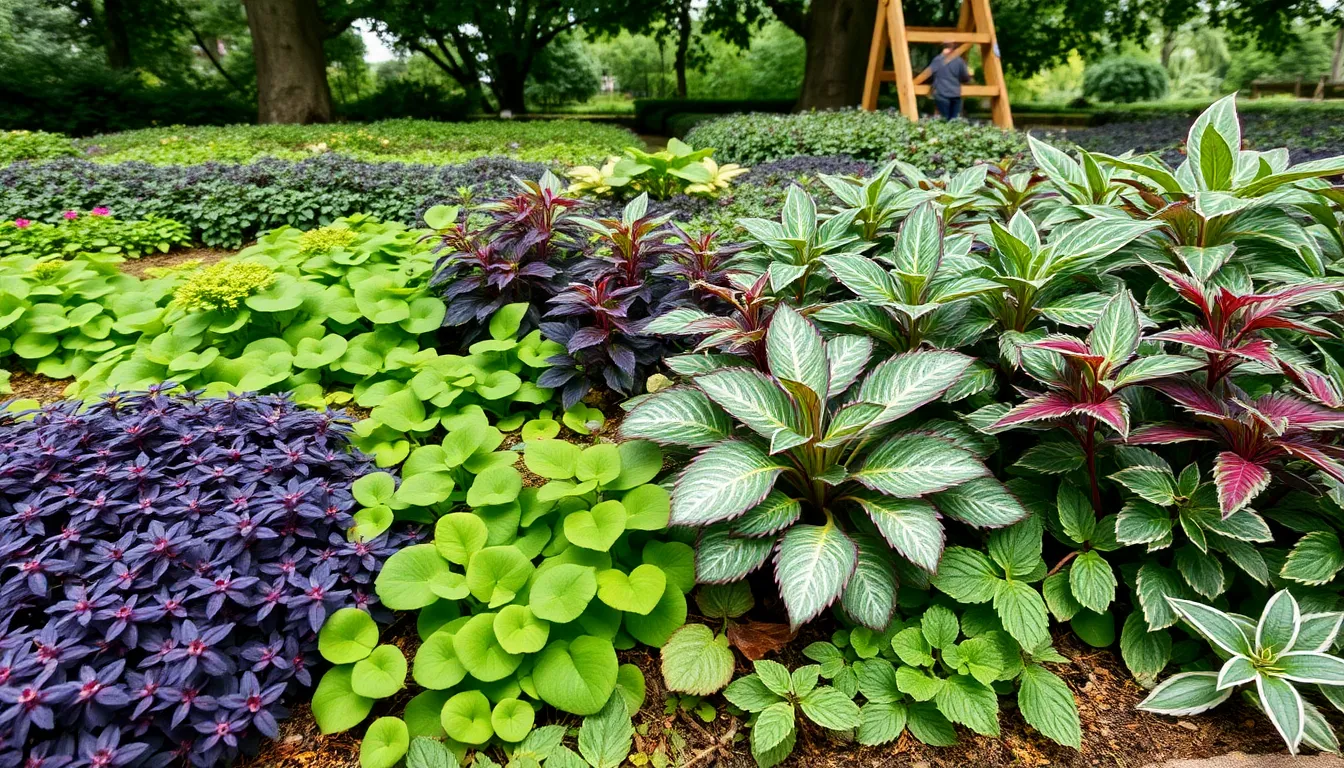
Problem areas in shade gardens require specialized ground cover answers that can handle challenging conditions while deterring deer browsing.
Ajuga for Dense Coverage
Ajuga forms incredibly dense mats that effectively smother weeds while creating a natural barrier deer typically avoid. Dense foliage coverage makes this bugleweed an excellent choice for shaded areas where traditional lawn grass struggles to establish. We recommend planting ajuga in spring for optimal establishment, as it spreads quickly to fill bare spots within a single growing season.
Rich purple, bronze, or variegated leaves provide year-round visual interest even when the distinctive blue flower spikes aren’t blooming. Ground hugging growth habit allows ajuga to thrive under trees where other plants fail, making it perfect for deeply shaded problem zones. Maintenance requirements remain minimal once established, requiring only occasional division every 3-4 years to prevent overcrowding.
Wild Ginger for Native Appeal
Wild ginger thrives in dense shade conditions where most other ground covers struggle, making it ideal for challenging woodland gardens. Heart shaped leaves create attractive natural carpets that deer instinctively avoid due to the plant’s aromatic properties and native resistance mechanisms. We’ve found this North American native particularly effective in moist, acidic soils beneath mature trees.
Natural deer resistance combines with exceptional shade tolerance to make wild ginger perfect for problem areas under evergreen trees. Spreading growth pattern allows colonies to establish gradually, creating sustainable ground cover that requires no supplemental watering once mature. Native wildlife benefits from wild ginger’s presence while deer consistently leave the foliage undisturbed throughout the growing season.
Lamium for Variegated Interest
Lamium provides striking silver and green variegated foliage that brightens even the darkest shaded corners of our gardens. Variegated leaves reflect light effectively, creating visual interest in areas where solid green plants appear dull or lifeless. We particularly appreciate how lamium’s dead nettle characteristics make it naturally unappealing to browsing deer.
Spreading habit allows lamium to cover ground quickly while maintaining its decorative appeal through small white or pink flowers in spring. Silver markings on leaves intensify in cooler weather, providing enhanced visual appeal during fall and early winter months. Low maintenance requirements make this ground cover ideal for steep slopes or areas where regular garden care proves difficult.
Tall Deer Resistant Shade Plants for Privacy and Structure
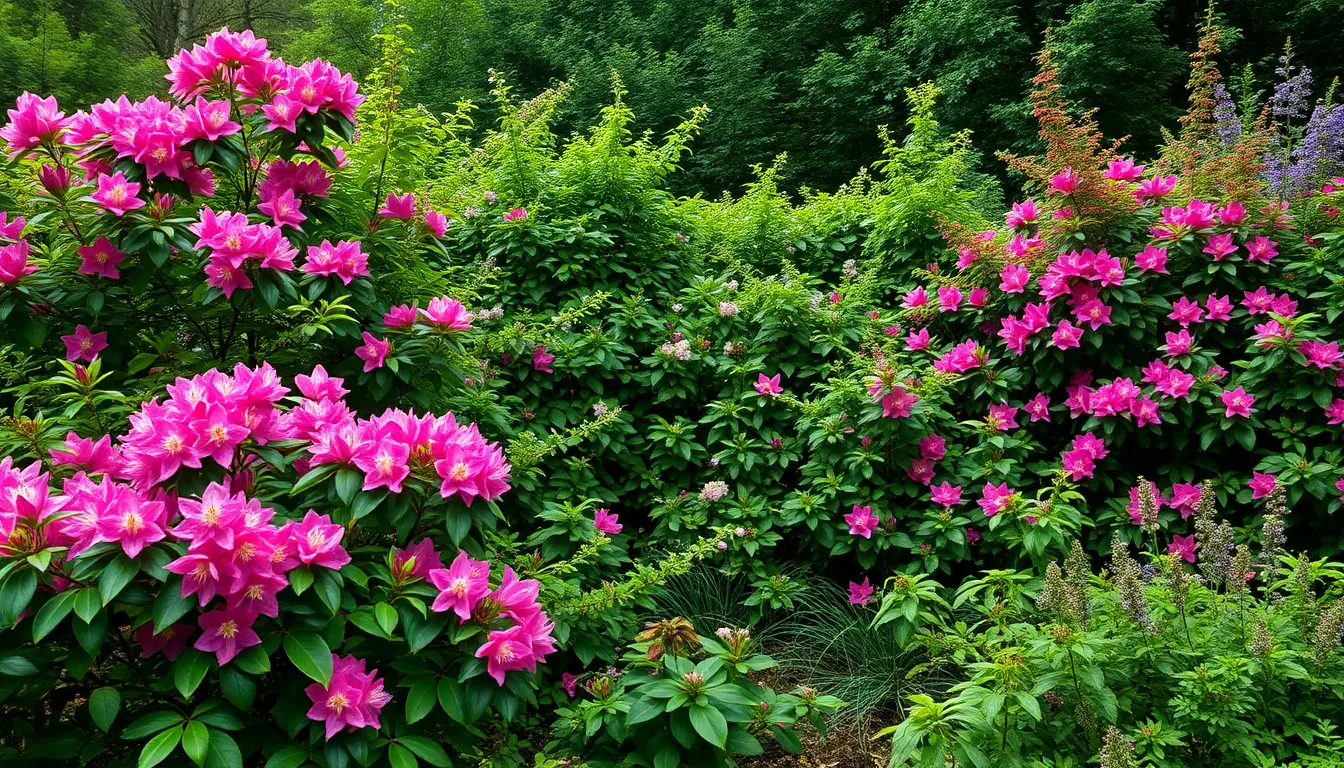
While ground covers create the foundation of our shade gardens, taller plants provide the privacy screening and structural backbone we need for complete industry design.
Rhododendrons for Dramatic Impact
Rhododendrons deliver stunning visual impact with their large clusters of vibrant flowers and glossy evergreen foliage that creates year-round privacy screens. These impressive shrubs thrive in shaded areas with well-drained, acidic soil conditions that many other privacy plants can’t tolerate. Deer consistently avoid rhododendrons due to their leathery leaf texture and naturally occurring toxic compounds that make them unpalatable.
We appreciate how rhododendrons grow tall enough to block unwanted views while maintaining their dense, structured appearance throughout all seasons. Their dramatic spring blooms in colors ranging from white to deep purple add spectacular seasonal interest to our privacy plantings. Most varieties reach heights of 6-12 feet, making them perfect for creating living walls in shaded areas where traditional privacy plants struggle.
Japanese Pieris for Spring Flowers
Japanese Pieris brings elegant bell-shaped flowers in early spring along with attractive evergreen foliage that provides consistent privacy coverage. This sophisticated shrub performs exceptionally well in partial to full shade with acidic, moist soil conditions. Deer naturally avoid Japanese Pieris because its foliage contains mildly toxic compounds that taste bitter and cause digestive discomfort.
We love how Japanese Pieris offers both functional privacy screening and ornamental value with its cascading flower clusters in shades of white, pink, and red. The plant’s compact growth habit makes it ideal for smaller spaces where we need privacy without overwhelming the garden design. Its bronze-tinted new growth adds an extra layer of visual interest that complements other shade plants in our industry.
Mountain Laurel for Native Beauty
Mountain Laurel provides native woodland appeal with its beautiful clusters of white to pink flowers in late spring and dense evergreen foliage for privacy. This hardy native shrub thrives in woodland settings with shade or filtered sunlight conditions. Deer won’t browse Mountain Laurel because of its tough, leathery leaves and toxic properties that make it completely unpalatable to wildlife.
We value Mountain Laurel’s ability to create natural-looking privacy screens that blend seamlessly with existing woodland landscapes. The plant’s dense branching structure provides excellent year-round coverage while its late spring flowers add native beauty that attracts beneficial pollinators. Mountain Laurel typically reaches 5-8 feet in height, making it perfect for medium-scale privacy applications in our shaded garden areas.
Seasonal Care Tips for Deer Resistant Shade Plants
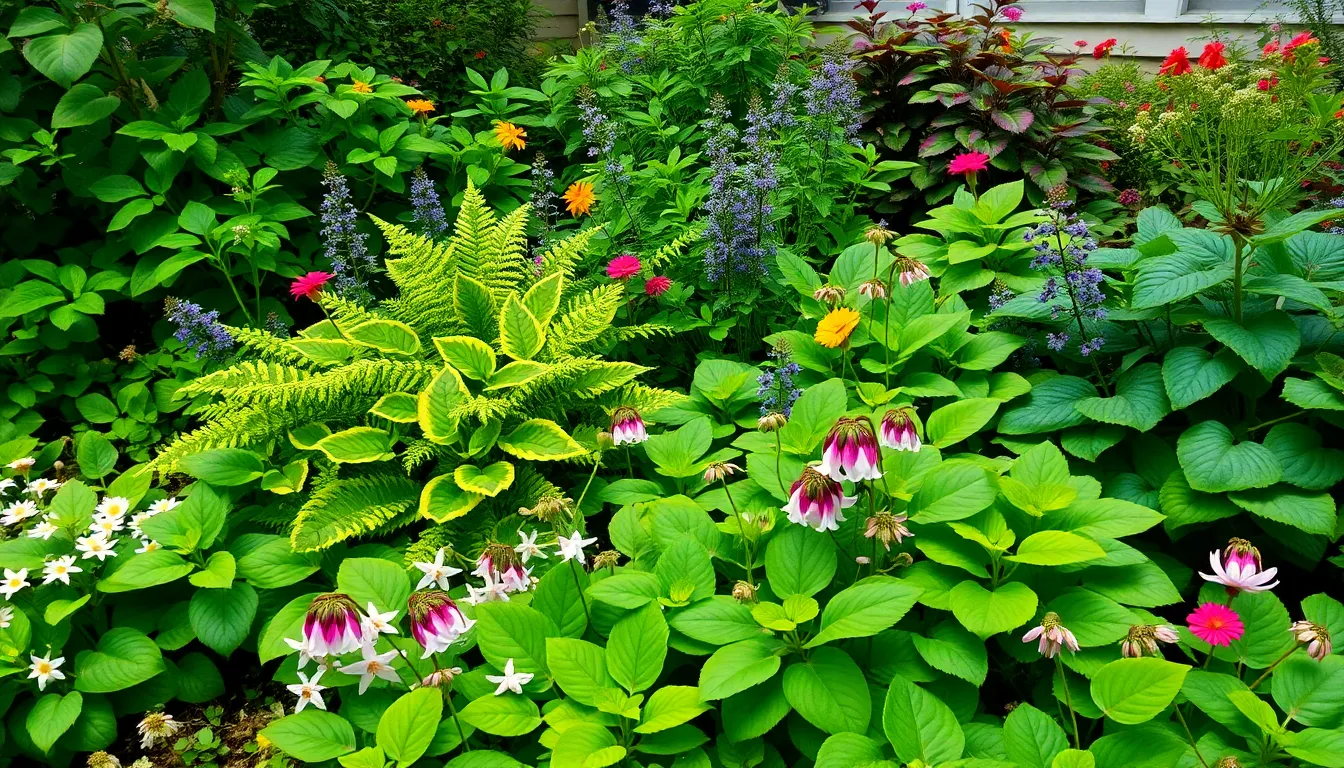
Proper seasonal care ensures our deer resistant shade plants remain healthy and continue to deter wildlife effectively. Following exact maintenance schedules throughout the year maximizes their ornamental value and resilience.
Spring Planting and Maintenance
Soil preparation becomes our first priority when establishing new deer resistant plantings in shaded areas. We enrich the planting site with organic matter to ensure proper moisture retention, as most shade loving species like Siberian Bugloss and Pig Squeak thrive in consistently moist conditions.
Timing our planting efforts correctly protects new installations from frost damage. We wait until the danger of frost passes before introducing tender varieties, while hardy plants like Helleborus can be planted earlier in the season.
Removing winter mulch and pruning dead foliage encourages vigorous new growth across our deer resistant plantings. We carefully cut back damaged stems from plants like Bergenia cordifolia, whose brown winter foliage should be cleared to make way for fresh spring growth.
Applying balanced fertilizer supports the nutritional needs of our established shade plants. We use a gentle, slow release formula that won’t burn delicate root systems while providing essential nutrients for the growing season.
Summer Watering Strategies
Maintaining consistent soil moisture proves critical for our deer resistant shade plants during hot summer months. We provide deep, thorough watering sessions rather than frequent shallow applications, allowing plants like Brunnera macrophylla to establish strong root systems in their preferred moist, well drained conditions.
Watering in early morning hours reduces disease risk and maximizes water uptake efficiency. We avoid evening watering sessions that can promote fungal issues, particularly important for plants with dense foliage like Japanese Painted Fern and Wild Ginger.
Mulching around plant bases conserves soil moisture and suppresses weed competition throughout the summer season. We apply a 2 to 3 inch layer of organic mulch, keeping it away from plant stems to prevent moisture related problems.
Monitoring drainage conditions prevents waterlogging that can damage even moisture loving shade plants. We ensure our deer resistant species receive adequate water without creating soggy conditions that compromise root health.
Fall Preparation and Winter Protection
Cutting back spent foliage improves garden appearance while preventing disease issues during winter months. We remove dead stems from plants like Sweet Woodruff and Lungwort, though we leave evergreen species like Pig Squeak intact since their foliage persists through winter.
Applying protective mulch around root zones shields our deer resistant plantings from freeze thaw cycles. We use a 3 to 4 inch layer of organic material like shredded leaves or bark chips, focusing on tender varieties that need extra winter protection.
Installing additional protection measures safeguards vulnerable plants in colder USDA zones. We wrap sensitive species with burlap or provide windscreen barriers, particularly important for plants at the edge of their hardiness range like certain Ajuga varieties.
Preparing irrigation systems prevents winter damage to watering equipment while ensuring spring readiness. We drain hoses and shut off water sources to protect our investment in both plants and garden infrastructure.
Creating a Complete Deer Resistant Shade Garden Design
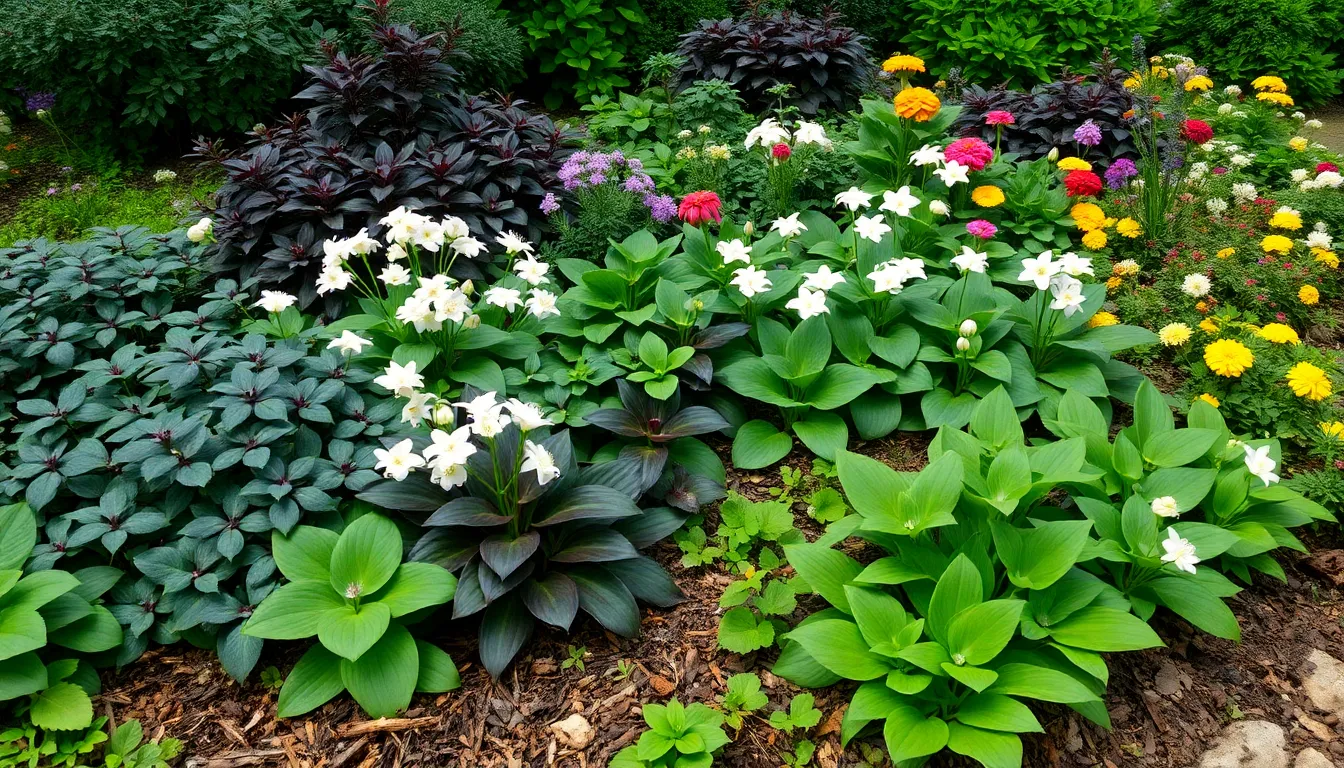
Now that we’ve covered individual plant choices, let’s focus on combining these deer resistant shade plants into a cohesive garden design that maximizes both beauty and protection.
Layering Plants for Maximum Impact
Layering creates visual depth while establishing natural deer barriers throughout your shade garden. We recommend starting with ground covers like Sweet Woodruff (Galium odoratum) as your foundation layer, which spreads across bare soil and eliminates spots deer might exploit. Medium height plants such as Ajuga cultivars add the next textural layer, providing colorful foliage that fills gaps between larger specimens.
Taller structural plants like Helleborus (Lenten Rose) form the backbone of your design, offering year round presence and early spring blooms. This three tier approach ensures continuous coverage from ground level to eye height, making it difficult for deer to find entry points into your garden. Varying bloom times across these layers extends seasonal interest while maintaining protection throughout the growing season.
Strategic placement of plants with different mature sizes prevents overcrowding and ensures each specimen receives adequate light. We’ve found that grouping plants with similar water requirements within each layer simplifies maintenance while creating natural looking plant communities.
Companion Planting Strategies
Companion planting pairs deer resistant species with complementary growth habits and environmental needs for enhanced protection. Plants like Pig Squeak (Bergenia cordifolia) work exceptionally well alongside moisture loving ferns, creating attractive combinations that deer consistently avoid due to texture and taste preferences.
Strong scented plants serve as natural repellent barriers when positioned near more vulnerable species in your garden. Japanese Painted Fern’s distinctive foliage and unpalatable texture makes it an excellent companion for protecting nearby plants that might otherwise attract deer attention.
Native shrubs like American Beautyberry add vertical structure while providing wildlife habitat and natural deer deterrent properties. These larger companions create microclimates that benefit surrounding shade plants while establishing clear boundaries deer typically respect.
Mixing plants with different defensive characteristics (fragrant foliage, fuzzy leaves, thick textures) creates overlapping protection zones throughout your garden space. This diversity ensures that if deer develop tolerance to one plant type, multiple other deterrents remain effective.
Maintenance Requirements and Long-Term Success
Deer resistant shade plants thrive with consistent moisture and well drained soil conditions that prevent root rot during wet periods. We recommend applying 2-3 inches of organic mulch around plants to retain soil moisture and suppress competing weeds that might compromise plant health.
Regular pruning maintains plant shape while encouraging healthy new growth that deer find less appealing than stressed or weakened specimens. Monitoring soil fertility and amending with compost annually ensures plants develop strong root systems that resist browsing pressure more effectively.
| Maintenance Task | Frequency | Purpose |
|---|---|---|
| Mulch application | Twice yearly | Moisture retention, weed suppression |
| Soil amendment | Annual | Maintain fertility and drainage |
| Pruning | As needed | Shape maintenance, healthy growth |
| Plant replacement | Every 3-5 years | Sustain resistance, refresh diversity |
Establishing robust plant health forms the foundation of long term deer resistance in shade gardens. Periodic addition of new resistant species maintains garden diversity while preventing deer from developing familiarity with existing plantings. We’ve observed that gardens with rotating plant selections maintain higher resistance levels over multiple growing seasons.
Consistent watering during establishment periods (first two years) builds strong root systems that support vigorous growth deer naturally avoid. Healthy, well maintained plants produce the chemical compounds and physical characteristics that make them naturally deer resistant.
Conclusion
We’ve shown you that creating a thriving deer-resistant shade garden isn’t just possible—it’s surprisingly achievable with the right plant choices and strategies. By selecting aromatic herbs textured perennials and layered plantings you’ll build a natural defense system that keeps deer at bay while maintaining year-round beauty.
The key lies in understanding both deer behavior and plant characteristics that work together seamlessly. When we combine fragrant foliage with proper seasonal care and strategic companion planting we create gardens that flourish without constant worry about deer damage.
Your shade garden can become a peaceful sanctuary that requires minimal intervention once established. With these deer-resistant options you’ll spend more time enjoying your outdoor space and less time replacing damaged plants.
Frequently Asked Questions
What makes a plant deer-resistant in shade gardens?
Deer-resistant shade plants typically have fragrant foliage, fuzzy or thick textured leaves, and dense growth habits. Deer rely heavily on their sense of smell to identify safe food sources, so aromatic plants like lavender and rosemary are naturally less appealing. Plants with tough, thick textures or fuzzy leaves are also avoided since they’re harder to digest.
Which evergreen plants work best for deer-resistant shade gardens?
Boxwood varieties and Japanese Pachysandra are excellent evergreen choices for shade. Boxwood provides structure and can be shaped for formal designs, while Japanese Pachysandra creates dense ground cover that deer typically avoid. Both maintain their appearance year-round and thrive in shaded conditions.
What flowering plants can I use that deer won’t eat in shade?
Astilbe, Hellebores, and Begonias are excellent flowering options for deer-resistant shade gardens. These plants add vibrant colors throughout the growing season while naturally deterring deer. Astilbe produces feathery plumes, Hellebores bloom early in spring, and Begonias provide continuous color in deeper shade.
How should I layer plants for maximum deer protection?
Create a three-tiered approach starting with ground covers like Sweet Woodruff at the bottom, medium-height plants like Ajuga in the middle, and taller structural plants like Helleborus at the back. This layering complicates deer access and creates visual depth while maximizing protection throughout your shade garden.
What maintenance do deer-resistant shade plants need?
Regular mulching, soil amendments, and seasonal pruning are essential for long-term success. Spring tasks include enriching soil and pruning, while summer requires consistent watering strategies. Fall preparation involves cutting back spent foliage, and winter protection includes applying protective mulch to safeguard plants from harsh conditions.
Can I use aromatic herbs in my deer-resistant shade garden?
Yes, fragrant herbs like certain lavender cultivars and Sweet Woodruff work well in partial shade and create natural barriers against deer. These aromatic plants emit scents that deer find unappealing, making them excellent choices for both their deer-resistant properties and their pleasant fragrance for humans.
What ground cover options work best for dense shade areas?
Ajuga and Wild Ginger are excellent ground cover choices that thrive in dense shade while deterring deer. Both plants spread naturally to create thick carpets that suppress weeds and provide consistent coverage. They’re particularly effective in areas where other plants struggle with low light conditions.
How do I prepare my soil for deer-resistant shade plants?
Proper soil preparation involves enriching the soil with organic matter, ensuring good drainage, and testing pH levels. Most shade plants prefer well-draining, slightly acidic to neutral soil. Adding compost or aged manure improves soil structure and provides essential nutrients for healthy plant establishment and growth.

